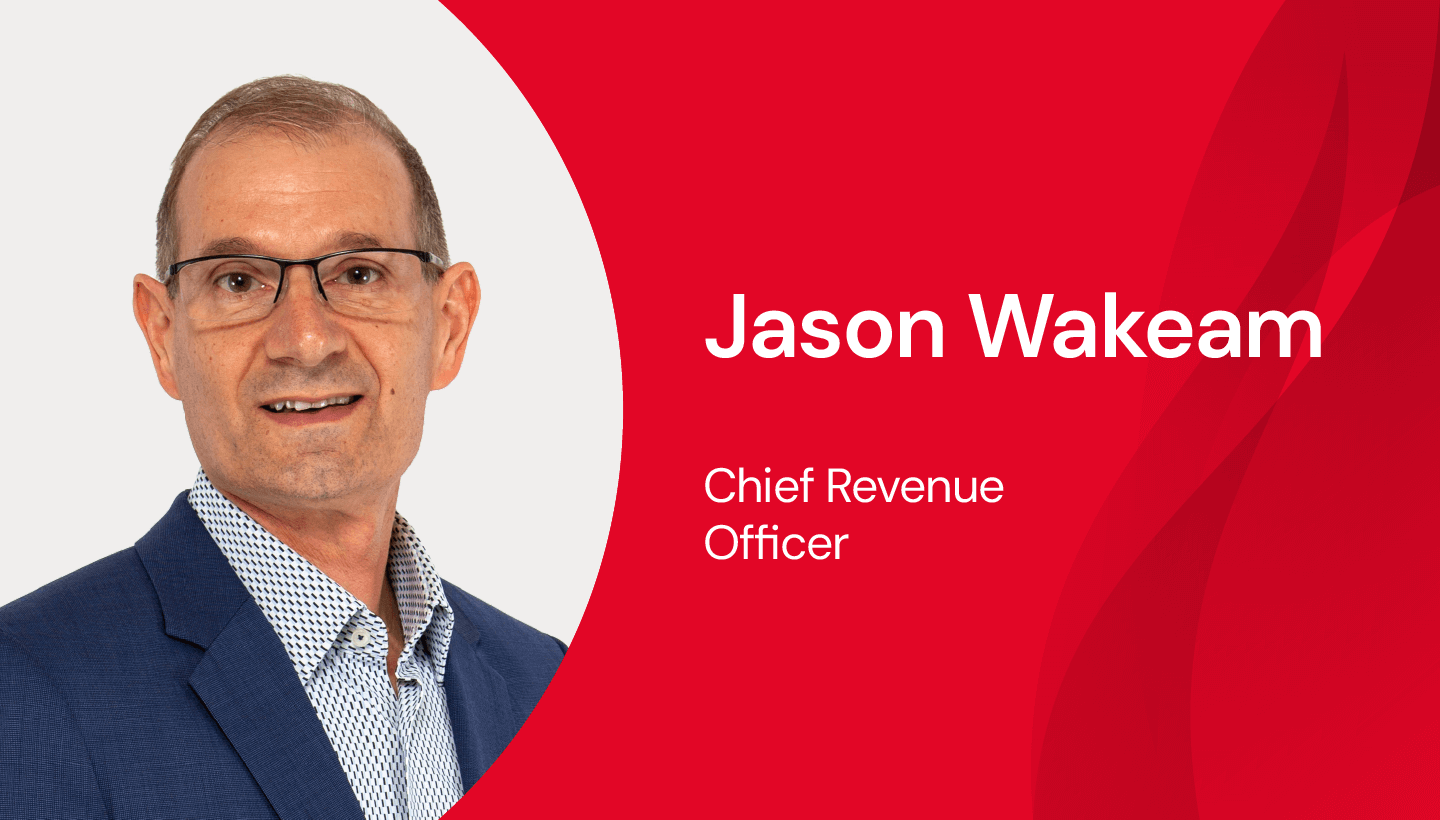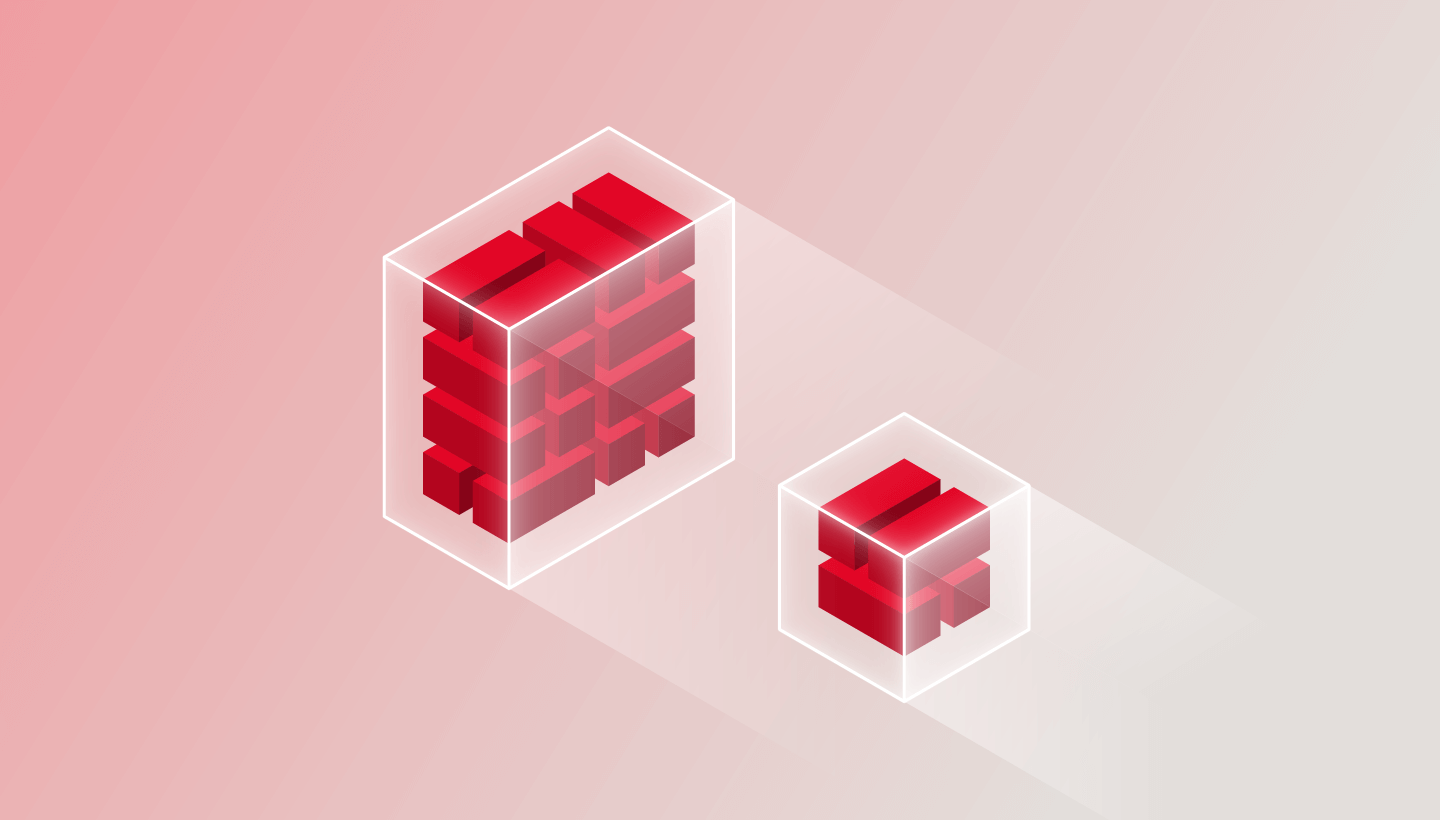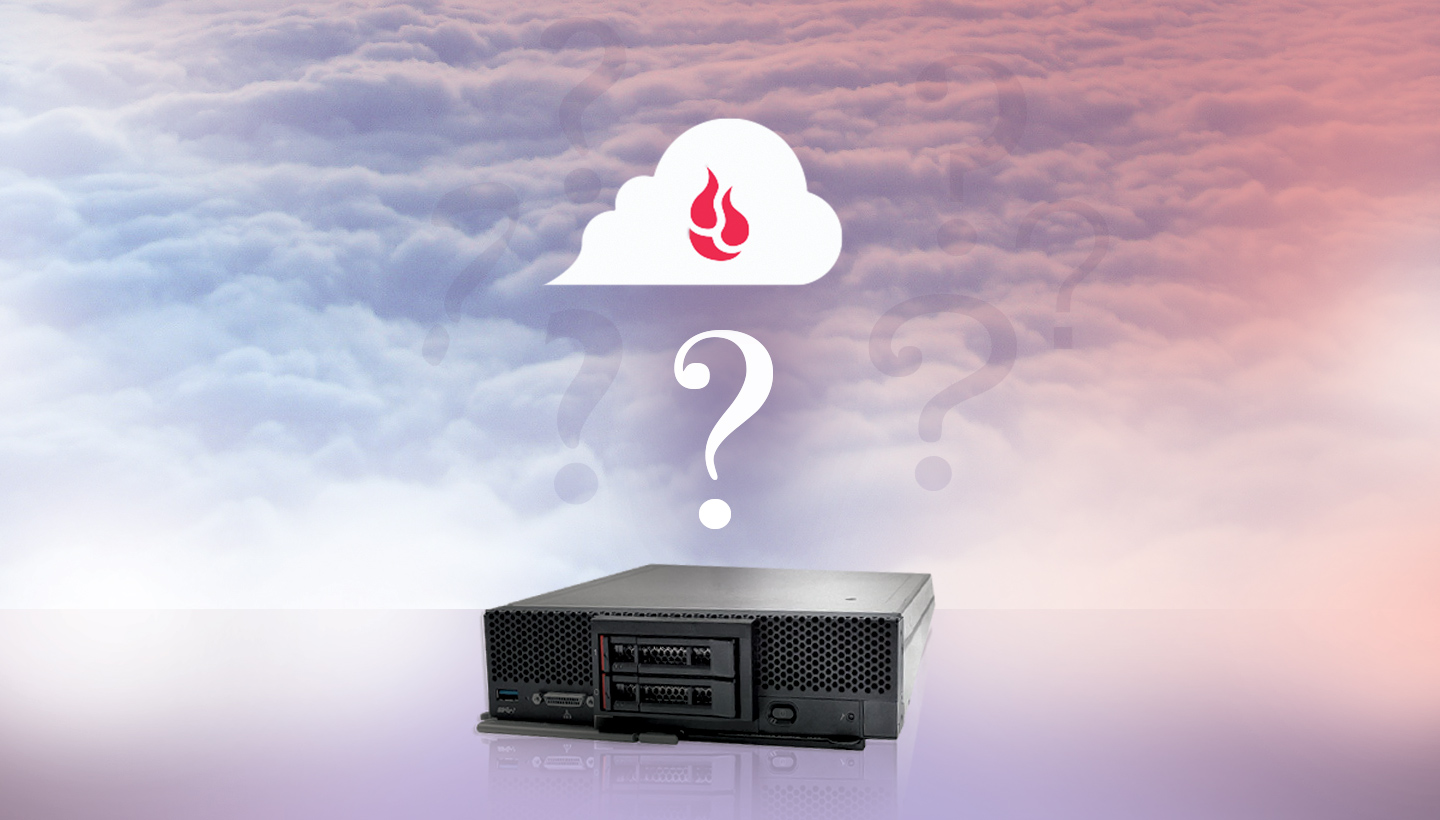
When you work in a resource-constricted business or organization, committing to any kind of investment that doesn’t directly contribute to your mission, your bottom line (or both) is incredibly hard. You only have a certain amount of cash, and if you’re not using it to build something that immediately returns value to your bottom line, you feel like you’re stealing from your own growth.
This is the reality for many nonprofits, media companies, foundations, production houses, and arts organizations. They often invest in cash-intensive products—music, video, literature, plays, service efforts, and/or historical or cultural preservation—that take months, if not years, to turn back into cash or grants the company can use for future efforts. Which means that, when it’s time to make investments in the company’s infrastructure, the decision making process can be brutal.
Do you invest in your office: the metaphorical leaking roof over your head? New technology that might (or might not) make your job easier? And how do you invest? Do you buy or rent? It all feels like a distraction from what you’re supposed to be working on, and possibly a misallocation of funds that could be supporting your core mission.
We want to help you with the decision.
A growing reality for businesses is the cost of protecting their legacy: All of the video, audio, text, and other files that their organization has created over the years came at great expense, so there’s no question that it needs to be appropriately stored and archived.
But, while the size of this data is growing, your budget to protect that data is most likely not. You have a decision to make: Try to manage this growth with an on-prem investment, or pay a cloud-based service to take care of it for you. In more simple terms, you’re making an age-old budgeting decision:
Whether to make an extensive capital investment, or to commit to an ongoing operational expense. In financial jargon, you’re debating “CapEx” vs. “OpEx”—and you’re not alone.
Let’s break down the decision one step at a time. First things first, let’s hammer out some terms in case you’re already lost. (If you’re roughly familiar with basic accounting principals, you can skip the following section. Otherwise, read on…)
Capital Expense (CapEx) vs. Operating Expense (OpEx)

What is CapEx?
Capital Expense (CapEx) (or expenditure, if you want to be fancy) is the price of buying or fixing an asset that will hold its value over time—think: vehicles, buildings, equipment, land, or say… a network-attached server (NAS) or some other piece of technology. You’re buying something that you will use over some period of time (often called its “useful life”).
What’s important to note is that this “expense” does not immediately hit your operating budget. At first, this is entirely a balance sheet item: the cash you spent for it simply moves from “Current Assets” on your balance sheet to “Equipment” under your “Long-term Assets.”
Nice deal, right? No net change! My hardware is now “free” for me except for the upkeep and power expenses. Not so fast.
Every type of capital asset has a “depreciation schedule.” This is accountant lingo for: Things fall apart and aren’t worth what you paid for them. So, the depreciation schedule is an estimation for how quickly or slowly an item loses its value to your business.
Technology typically depreciates on a 3 or 5 year basis. What this means is, if you buy a $10,000 NAS on January 1st, and your auditor determines its useful life to be 3 years, then your depreciation schedule will recognize a loss of $3,333.33 in value for the asset at the end of the year for the next three years. Once you reach three years the asset can be removed from your depreciation schedule and it isn’t “worth” anything on your balance sheet anymore (though it may still be quite functional and an essential part of your IT infrastructure).
But, as we know: The whole idea in a balance sheet is that it “balances” right? So if your assets are decreasing in value, you need to acknowledge that loss somewhere or your finances will be out of whack. So where does the decrease go? Into your operating budget! You have to acknowledge depreciation as an operating expense.
This is where your Capital Expense becomes an Operating Expense: The depreciation value has to go somewhere, and that somewhere is your bottom line. Accounting principles dictate that you have to incorporate the amount your assets have depreciated into your operating budget as an expense.
And that’s how Capital Expense works (at least, from a very simple perspective). You buy something—often pulling directly from your cash—and then you acknowledge its expense incrementally, over a set schedule, in your operating budget.
What is OpEx?
Operating Expense (OpEx) is typically easier for folks to wrap their head around. These are the ongoing costs you incur to run your business or organization. Think: rent, internet, office supplies, kibble for the office cat—that sort of thing. Unlike your capital expenses, the operating expenses hit your bottom line immediately, typically flowing through your general or administrative lines. No smoke and mirrors here—you spend the money, you get what you paid for, your monthly financials reflect the expense, and hopefully it contributes positively to your bottom line!

Why Do CapEx and Opex Matter for Data Storage?
We get it, the ins and outs of a balance sheet are tantalizing to a small number of people (sheepishly, I count myself amongst them). BUT: The implications of the difference between CapEx and OpEx can be hugely impactful when it comes to fulfilling your organization’s mission or your businesses’ goals.
Let’s see if we can bring the implications into more useful perspective:
Let’s say that you’re an organization with a growing archive of data, and you have a reliable projection for your data growth rate over the coming years. Maybe you’re a music education nonprofit, and part of your mission is archiving the performance recordings of all of your students for their use in future school applications or tryouts.
You have around 200TB worth of data that you need to get onto a more reliable, accessible storage media ASAP (your volunteer librarian just retired and now nobody knows how she organized the tape archive… bummer). What do you do?
You call your freelance IT consultant, and they give you two options:
1) An On-Prem Storage Solution: The simplest way to describe an on-premises solution is: A machine that is visible. It’s in a space you own or rent, it is “bought and paid for,” and your auditor or bookkeeper flagged that it should be depreciated.
Data storage comes in “on-prem” shapes and sizes too. Whether it’s a Network Attached Server (NAS) or a Storage Area Network (SAN), your IT guy will quote out something for you to plug in onsite that will take care of your archiving issue. This type of storage is a capital expense.
2) A Cloud Storage Solution: The “cloud” is often described as “someone else’s computer.” It’s a pretty apt description in this case. In a cloud storage solution, you pay another company—typically on a monthly basis—to store, protect, and maintain your data. So if on-prem is a “visible” solution, this is an “invisible” solution. And because it’s a service, it’s a simple monthly operating expense. Cloud storage doesn’t depreciate because the company providing is constantly paying to maintain.
What is This Really Going to Cost?

Let’s say you have roughly 200TB you need to get into a better archiving solution. This is about 25 years worth of content, so you’re expecting (with a little room for data inflation) to add around 30 Terabytes a year of data. What will your two options really cost you, once we pull apart the financial jargon?
On-Prem Storage Solution:
For your server hardware, your hard drives, and a reliable power supply unit, you’ll likely end up paying around $25,000. Let’s assume your audit determines a useful life of three years for the server, that means you’ll have a depreciation of $694 per month.
Don’t forget, however, that you’ll need to pay for power and possibly cooling (estimated around $100 per month for this size of server), some IT assistance to help with upgrades and maintenance (let’s say $50 per month), and you have to pay for the space to hold it. We’ll leave the latter at zero—you probably have a closet somewhere.
So all in, you’ll need to lay out $25K in cash at the outset, and then you’ll be recognizing the expense in your operating expense to the tune of $850 every month for the next 3 years.
Cloud Storage Solution:
The biggest expense on the front end of a cloud solution is the expense of ingesting data. There are a number of services you can use, but it’s easiest for us to quote out our own: B2 Cloud Storage. If you want to move quickly, you can rent our Fireballs, which we’ll ship to you at a price of $550 per month, and you can upload 70TB at a time and ship them back to us for upload. So, all together, you’d pay $1,650 for the trouble of moving the data at the speed of FedEx, which is typically far faster than the internet. (If you have the time to let your data upload over the internet for months, then you can do that for far less). We’ll spread this expense across 3 years to make our comparison more apples-to-apples. So let’s say $46 a month.
After this initial expense, you simply have to pay a monthly data storage bill. We’ll use Backblaze B2 for estimating. At 200TB, you’ll be paying $1,000 a month, right now, but that number will grow along with your data, at $5/TB.
So you’re laying out $1,500 in your first month, then $1,000 a month, growing at $5/TB per month.
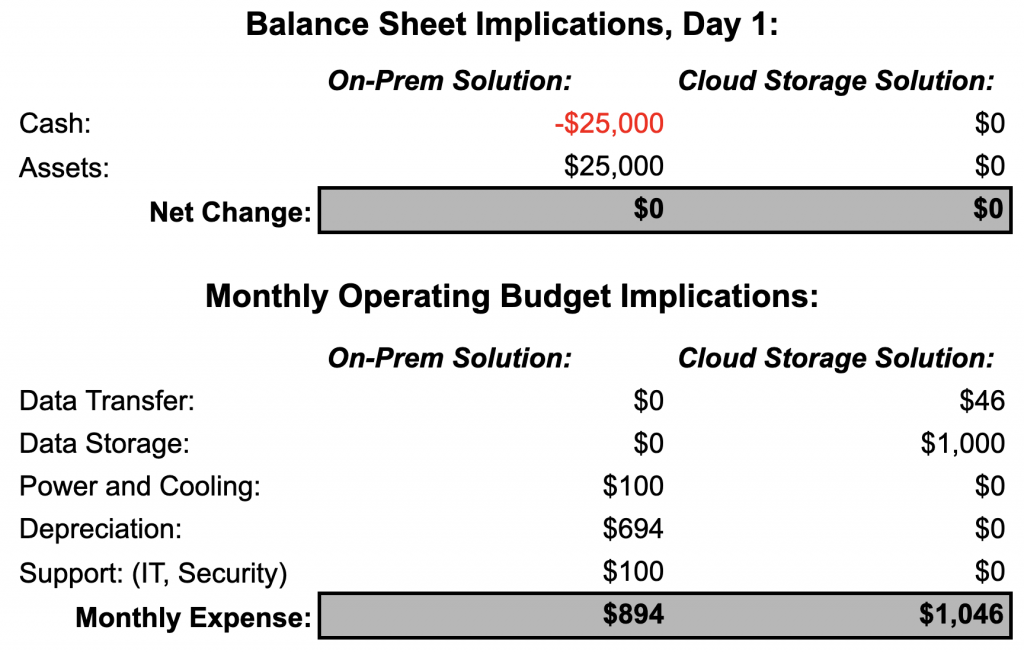
What’s the Real Difference? Or, What Are a Few Hundred Dollars Worth?
To emerge from the weeds for a moment: The simple difference between these two options is a few hundred dollars on a month to month basis. Let’s explore what those hundreds get you when it comes to your cash flow, long-term flexibility, maintenance, and your real estate bill.
Cash Flow
On-Prem Storage Solution: On day one working with your NAS or SAN, you’re out $25,000. And unless the hardware is defective, you will never be able to get that full value back.
Cloud Storage Solution: By the end of “month one” for Cloud, you might be out $1,000, maybe $2,000, depending on the upload service you use and the upload speeds you achieve.
So the question here is: How important is cash flow to you? What’s the opportunity cost of not being able to use that $22K for something else?
Long-Term Flexibility
How good of a forecaster are you? It may sound like an odd question but it’s actually critical to choosing the right solution. If you can accurately forecast the data needs of your company for the next five years you should be able to pick an on-prem solution that will match those needs. On the other hand if you are off in either direction you will end up spending money inefficiently. Let’s take a look at how both scenarios play out.
Overestimating Data Needs:
On-Prem Storage Solution: On day two working with your NAS or SAN, you are locked in to your investment of $25,000. You can’t return it, you can’t make it smaller. And the decrease in cash is only the beginning of your commitment. On an annual or monthly basis, going forward, you will need to recognize your investment’s depreciation, which will be a fixed amount no matter how long the hardware is in operation.
Cloud Storage Solution: On day two working in the cloud, you could choose to deprecate some of your data or recategorize it, and decrease your monthly spend. Alternatively, you could change cloud services if your existing arrangement isn’t working. The important thing is, you are not locked in to investment, and you can exit the arrangement at any time.
Underestimating Data Needs:
On-Prem Storage Solution: On day 425 you might realize that your NAS or SAN isn’t going to be enough storage for your operations. Most organizations make budgets for their operations, and most of them wouldn’t mind beating those projections. The problem is, if you’re able to achieve more in a given year, you will likely also generate more data in that year. If your business takes off and you’re locked into an on-prem solution, your only remedy will be to invest in higher capacity drives, or even to add an additional storage solution, both of which incur additional upfront cash outlays.
Cloud Storage Solution: If you reach day 425 and your organization is unexpectedly beating projections by a significant margin, your cloud storage service can easily scale to match your needs. Your monthly expense will increase but only at a fractional percentage since no new equipment will need to be purchased.
The questions here are: Are you ready to project how your data will scale over the next three to five years? And are you ready to cover the costs if you’re wrong?
Upkeep, Updates, and Repairs
On-Prem Storage Solution: On day 483, your NAS or SAN may not keep up with technology, or it may disagree with some other tech you need. But you’re stuck with it, and you’re stuck with the tab of paying to maintain and troubleshoot the aging technology. Whether you have your own IT staff, or hire consultants or an IT service, this could add significant cost to your overall on-prem storage budget. And it goes without saying that your server could simply cease functioning at any time.
Cloud Storage Solution: A cloud storage service will continue to run. It will always be improved. It will always be maintained. And in some cases, depending on how you’re uploading the data, it can even be self-healing. Some cloud storage solutions will perform checks to ensure that the data they’re storing is not degrading or hasn’t been lost. As such, these services are considered “self-healing,” because when they discover an inconsistency, they’ll call the users files to re-upload or use their own built-in redundancies to fix or replace the affected files.
And, of course, a cloud solution will have a staff of people—experts, often—working day in and day out to maintain and improve your storage. You don’t pay anything additional for their services. You don’t have to recruit, train, or manage them. They’re on the job entirely to ensure your service is never disrupted.
Real Estate, Energy, and Security
On-Prem Storage Solution: As your data grows, so will your need to maintain the space for it. You will need to devote increasingly large amounts of real estate to the footprint of your on site storage. You’ll have to provide adequate cooling and energy, and you’ll need to think differently about your approach to security. If you don’t have the space on site, that means you’ll need to expand or find additional real-estate elsewhere to make more room for servers. Depending on the real estate market you’re in, the costs for such an expansion could be well more than the monthly depreciation for your hardware.
Cloud Storage Solution: Cloud storage services are in the business of providing real estate, climate control, and over-the-top security for your data. Most cloud storage service providers have multiple data centers in order to quickly scale to meet your growing storage needs.
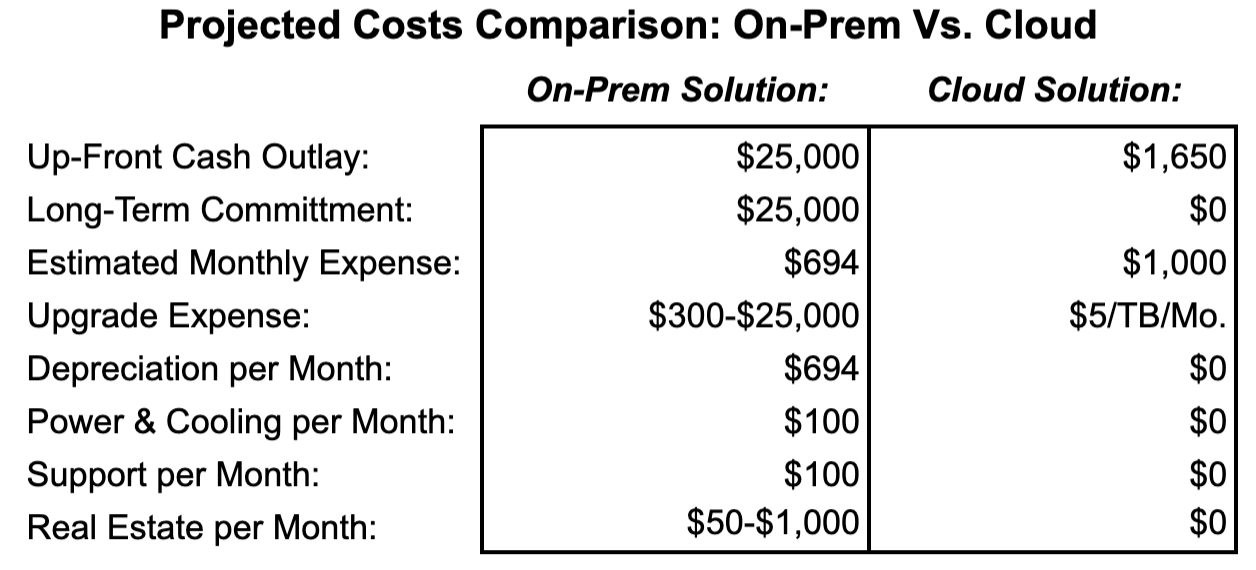
Final Thoughts on CapEx vs. OpEx
Viewed simply, setting up an on-prem archiving solution seems like a good deal. You’ve got your asset on site, the immediate budget implications are shunted off to your balance sheet, and everything else is IT’s problem. But, when you look past day one of your purchase, it might be less attractive: You have cash tied up in a vulnerable asset. You have a financial commitment that you can’t easily scale up or down. You have a tool that is only going to be maintained or improved when something goes very wrong. You have another presence in your office that is a space and energy hog.
On the flip side, with cloud storage, you have a monthly payment that takes care of all of this for you. Your cash is more available and flexible. You have zero concerns about scaling issues. Security, reliability, durability, upgrades, up-time, energy use, file maintenance—all of these are part of what you’re paying for on a monthly basis.
Maybe you love tinkering with hardware and being able to see where your data is resting. If that’s you, well, then CapEx is your jam. But if all of the concerns listed above are things you’d rather not worry about (I mean, you probably have more interesting things to work on, right?), then cloud storage is probably a better deal. CapEx vs. OpEx, that is the question—which is wiser? We’ll leave the answer up to you.



